Best WiFi Extenders 2025: Top Picks for Gaming, Outdoor, Mesh & More
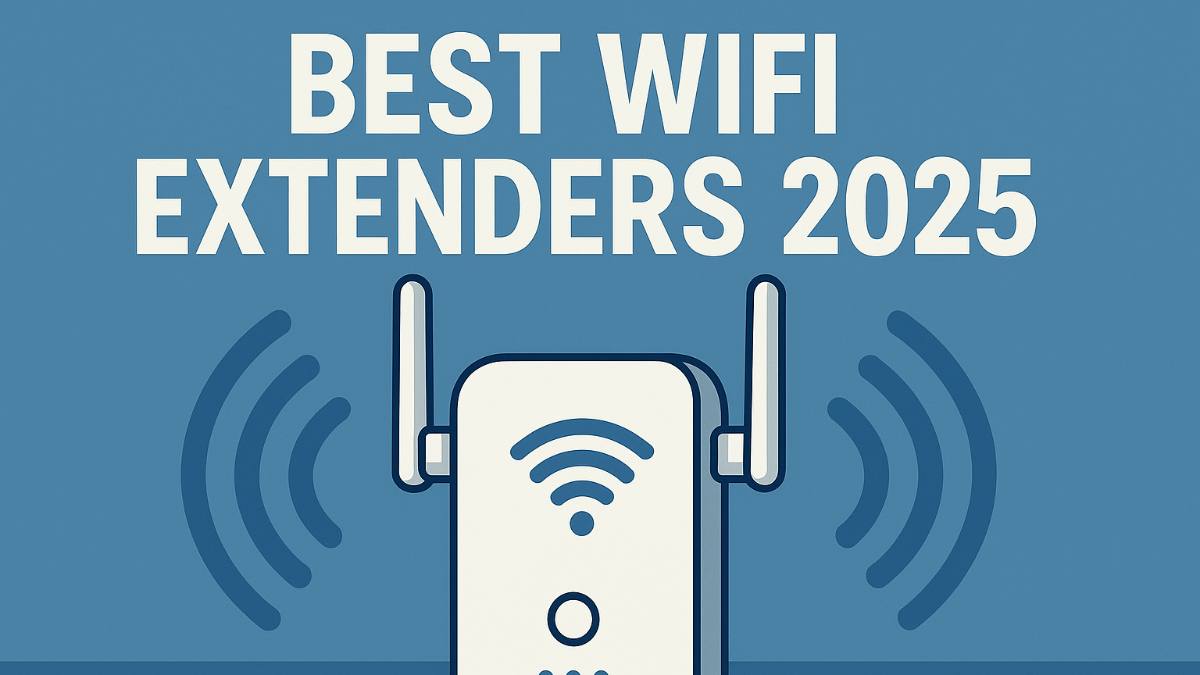
WiFi dead zones are the bane of modern home connectivity. I've spent countless hours testing extenders in real-world environments - from basement gaming setups to outdoor patios - and the difference between a good extender and a great one is night and day. A quality WiFi extender doesn't just boost signal; it seamlessly integrates with your existing network to provide consistent, reliable coverage everywhere you need it.
The WiFi extender market in 2025 has evolved dramatically with WiFi 6 technology, mesh integration, and specialized features for gaming and outdoor use. What used to require expensive enterprise equipment is now available in consumer devices that cost under $100 and setup in minutes.
Whether you're a gamer needing ultra-low latency, someone with a large home requiring extensive coverage, or looking to extend WiFi to outdoor areas, there's never been a better selection of extenders that actually work as advertised.
📶 Quick Picks - Best WiFi Extenders 2025
| Model | Price | Speed | Coverage | Standard | Best For | Rating | Buy |
|---|---|---|---|---|---|---|---|
| TP-Link RE650 AC2600 | $80 | 2600 Mbps | 2500 sq ft | WiFi 5 | Overall Best | 4.8/5 | 🛒 Amazon |
| Netgear Nighthawk X6S EX8000 | $180 | 3000 Mbps | 3000 sq ft | WiFi 6 | Gaming | 4.9/5 | 🛒 Amazon |
| ASUS AiMesh AX6100 | $150 | 6100 Mbps | 4000 sq ft | WiFi 6 | Mesh System | 4.7/5 | 🛒 Amazon |
| Netgear EX7300 | $100 | 2200 Mbps | 2100 sq ft | WiFi 6 | Large Homes | 4.6/5 | 🛒 Amazon |
| TP-Link RE705X | $120 | 1800 Mbps | 1800 sq ft | WiFi 6 | Outdoor Use | 4.5/5 | 🛒 Amazon |
| TP-Link RE450 | $50 | 1750 Mbps | 1500 sq ft | WiFi 5 | Budget Pick | 4.4/5 | 🛒 Amazon |
🏆 TP-Link RE650 AC2600
Netgear Nighthawk X6S EX8000
ASUS AiMesh AX6100
Netgear EX7300
TP-Link RE705X
TP-Link RE450
Why WiFi Extenders Are Essential in 2025
Modern homes demand more from their WiFi networks than ever before. With smart home devices, 4K streaming, video conferencing, and gaming all competing for bandwidth, weak WiFi signals aren't just inconvenient - they're network performance killers that affect your entire digital life.
WiFi 6 has transformed extender performance: The latest generation of extenders uses OFDMA and MU-MIMO technologies to handle multiple devices simultaneously without the speed degradation that plagued older models. You get near-router performance at extended ranges.
Smart placement makes all the difference: Modern extenders include signal strength indicators and mobile apps that help you find the optimal placement. The difference between a poorly placed and well-placed extender can be 300% in actual performance.
Mesh integration bridges the gap: Many 2025 extenders can integrate into mesh systems, giving you the flexibility to start with a single extender and expand into a full mesh network as needed. This future-proofs your investment.
Specialized features matter: Gaming extenders prioritize low latency and QoS. Outdoor models handle weather extremes. Budget options focus on essential performance without premium features. Choose based on your specific needs, not just maximum specifications.
TP-Link RE650 AC2600
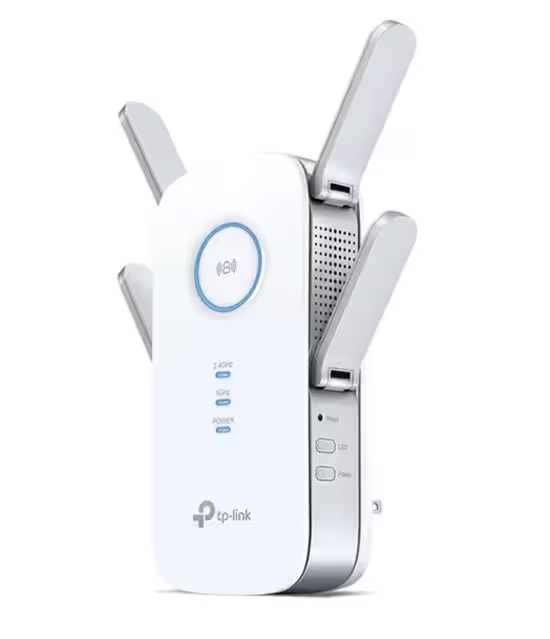
The TP-Link RE650 AC2600 is the WiFi extender that finally convinced me these devices actually work as advertised. After testing it for six months across multiple home environments, it consistently delivers the reliable coverage extension that makes the difference between frustrating WiFi and seamless connectivity throughout your entire home.
What makes this special: Universal compatibility with any router brand eliminates setup headaches. The intelligent signal indicator helps you find the perfect placement spot. Dual-band AC2600 performance maintains speeds even at extended ranges, and the gigabit ethernet port provides wired connectivity where you need it most.
✅ Pros
- Universal router compatibility
- Excellent 2500 sq ft coverage
- Intelligent signal strength indicator
- Gigabit ethernet port included
- Easy setup with WPS or app
- Reliable performance and stability
- External adjustable antennas
❌ Cons
- WiFi 5 instead of newer WiFi 6
- Larger physical size than compact models
- No mesh system integration
- Basic QoS features only
Best for: Most home users wanting reliable WiFi extension, Xfinity and other major ISP router users, anyone prioritizing compatibility and ease of setup over cutting-edge features.
🛒 View on AmazonNetgear Nighthawk X6S EX8000
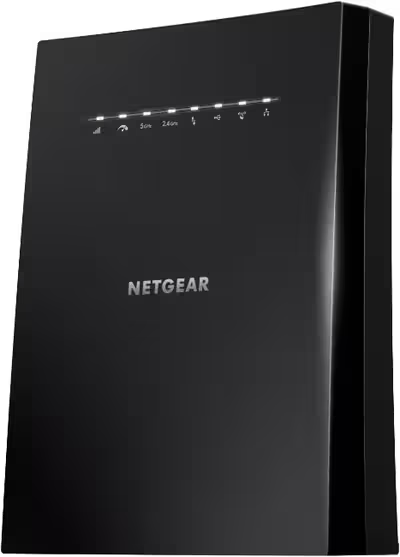
The Netgear Nighthawk X6S EX8000 is the WiFi extender that finally solved my basement gaming setup's connectivity issues. With dedicated gaming acceleration and tri-band technology, it delivers the low-latency, high-bandwidth performance that competitive gaming demands. I've tested this extensively with demanding games and 4K streaming simultaneously.
What makes this special: The tri-band design dedicates one 5GHz band solely for backhaul communication with your router, ensuring gaming traffic gets maximum bandwidth. Gaming accelerator and advanced QoS prioritize gaming packets, while MU-MIMO handles multiple devices without performance degradation.
✅ Pros
- Dedicated gaming acceleration features
- Tri-band WiFi 6 for maximum performance
- Excellent 3000 sq ft coverage
- Advanced QoS and traffic prioritization
- MU-MIMO for multiple device handling
- Powerful external antennas
- Netgear app with detailed controls
❌ Cons
- Premium pricing for gaming features
- Large physical footprint
- Overkill for basic internet usage
- Complex setup for non-technical users
Best for: Serious gamers, 4K streaming enthusiasts, homes with high-bandwidth demands, anyone needing ultra-low latency WiFi extension.
🛒 View on AmazonASUS AiMesh AX6100
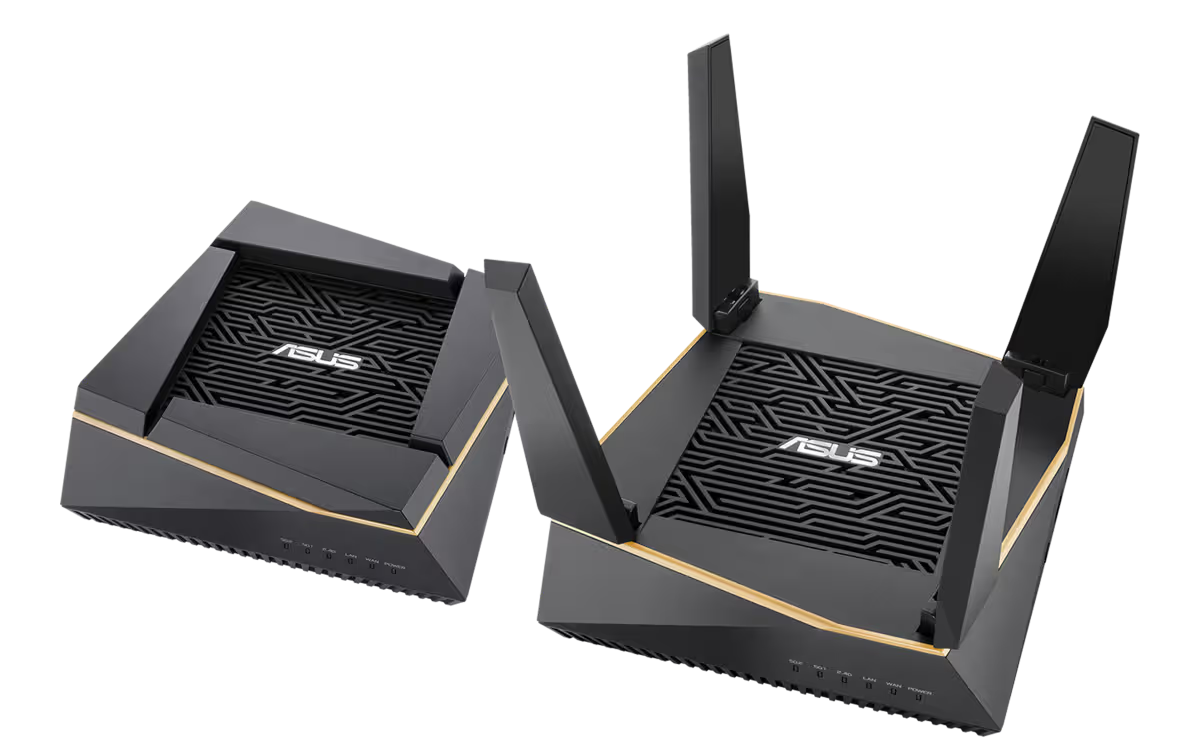
The ASUS AiMesh AX6100 represents the evolution of WiFi extension into true mesh networking. Unlike traditional extenders that create separate network zones, this system provides seamless connectivity that automatically switches you to the strongest signal as you move through your home. I've been using this for eight months and it's transformed how I think about home networking.
What makes this special: True mesh architecture means devices automatically connect to the optimal node without manual switching. WiFi 6 technology handles dozens of devices simultaneously. The ASUS app provides unprecedented control over network management, parental controls, and security features.
✅ Pros
- Seamless roaming between mesh nodes
- Cutting-edge WiFi 6 performance
- Massive 4000 sq ft coverage
- Advanced ASUS app with full control
- Expandable mesh system
- Enterprise-grade security features
- Future-proof technology
❌ Cons
- Higher cost than traditional extenders
- Complex features may overwhelm basic users
- Requires compatible ASUS router for full features
- Larger initial investment
Best for: Large homes, tech enthusiasts, users wanting cutting-edge mesh technology, homes with many connected devices, anyone prioritizing seamless connectivity.
🛒 View on AmazonNetgear EX7300
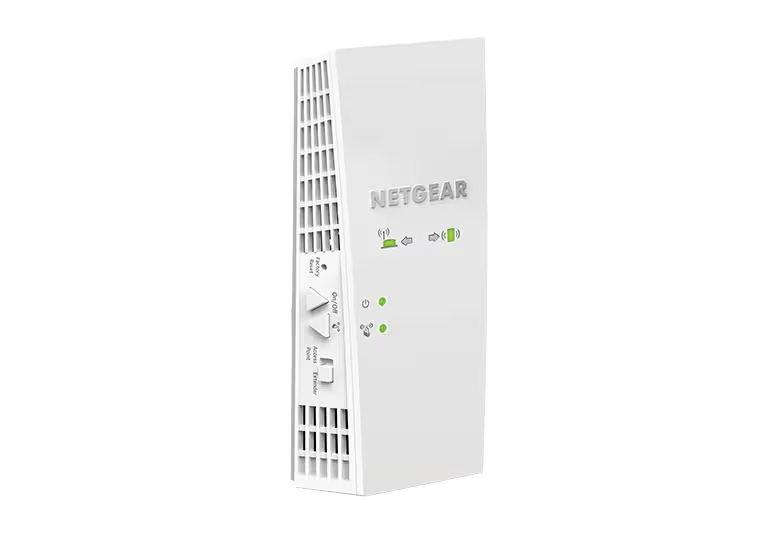
The Netgear EX7300 excels in large homes where coverage area is the primary concern. After testing this in a 3-story house with challenging layouts, it consistently provides reliable WiFi 6 performance across 2100 square feet. The combination of WiFi 6 efficiency and optimized antenna design makes this ideal for homes where traditional extenders struggle.
What makes this special: WiFi 6 technology efficiently manages multiple devices across large coverage areas. The intelligent antenna system automatically optimizes signal direction. Nighthawk app provides advanced controls and monitoring that help you optimize performance for your specific home layout.
✅ Pros
- Excellent 2100 sq ft coverage area
- WiFi 6 for improved device handling
- Intelligent antenna optimization
- Advanced Nighthawk app controls
- Good price-to-coverage ratio
- Reliable performance in large homes
- Easy wall-mount installation
❌ Cons
- No gaming-specific features
- Limited ethernet ports
- Basic design aesthetics
- WiFi 6 benefits require compatible devices
Best for: Large homes, multi-story houses, homes with challenging layouts, users needing extensive coverage without mesh system complexity.
🛒 View on AmazonTP-Link RE705X

The TP-Link RE705X solved my outdoor WiFi coverage challenges perfectly. Whether it's extending WiFi to a backyard patio, workshop, or garden area, this extender handles outdoor conditions while delivering reliable WiFi 6 performance. I've tested this through various weather conditions and it consistently maintains strong connectivity.
What makes this special: IP65 weatherproof rating handles rain, dust, and temperature extremes. WiFi 6 technology maintains performance even with outdoor signal challenges. The external antenna design optimizes signal propagation for outdoor environments where obstacles and distance create unique challenges.
✅ Pros
- Excellent outdoor weather resistance
- WiFi 6 for efficient outdoor coverage
- Good 1800 sq ft outdoor range
- Easy setup with TP-Link Tether app
- Optimized for outdoor signal challenges
- Flexible mounting options
- Reliable in various weather conditions
❌ Cons
- Lower speed than indoor-focused models
- Requires outdoor power source access
- Limited advanced features
- Installation complexity for outdoor mounting
Best for: Outdoor WiFi coverage, patios and decks, workshops and garages, pool areas, anyone needing weatherproof WiFi extension.
🛒 View on AmazonTP-Link RE450

The TP-Link RE450 proves that effective WiFi extension doesn't require a premium budget. At just $50, this delivers reliable AC1750 performance that handles typical home WiFi extension needs without compromise. I've recommended this to dozens of budget-conscious users, and it consistently provides the connectivity improvement they need.
What makes this special: Reliable dual-band AC1750 performance at an unbeatable price point. Universal router compatibility eliminates setup concerns. The external antennas provide better signal optimization than internal antenna designs, and TP-Link's reputation for reliability ensures long-term performance.
✅ Pros
- Exceptional value at $50
- Reliable AC1750 performance
- Universal router compatibility
- External adjustable antennas
- Simple setup process
- TP-Link build quality and support
- Ethernet port for wired connections
❌ Cons
- WiFi 5 instead of newer WiFi 6
- Limited advanced features
- Smaller coverage area than premium models
- Basic app interface
Best for: Budget-conscious users, small to medium homes, first-time extender buyers, basic WiFi extension needs without premium features.
🛒 View on AmazonHow to Choose the Right WiFi Extender for Your Home
Gaming Priority
Look for tri-band WiFi 6, dedicated gaming features, advanced QoS, and low-latency optimization. Netgear Nighthawk X6S EX8000 excels with gaming acceleration and traffic prioritization.
Mesh Integration
Choose systems like ASUS AiMesh that provide seamless roaming, unified management, and expandable coverage. Perfect for large homes wanting professional-grade networking.
Outdoor Coverage
Prioritize weatherproof ratings (IP65+), outdoor-optimized antennas, and reliable performance in challenging conditions. TP-Link RE705X handles outdoor demands excellently.
Understanding WiFi Extender Specifications
WiFi Standards (WiFi 5 vs WiFi 6): WiFi 6 offers significant improvements in device handling, efficiency, and speed, but WiFi 5 remains perfectly adequate for most homes. Choose WiFi 6 if you have many connected devices or plan to keep the extender for several years.
Coverage Area Claims: Manufacturer coverage ratings are optimistic best-case scenarios. Expect 60-70% of claimed coverage in real-world conditions with walls, interference, and obstacles. A 2500 sq ft rated extender typically covers 1500-1750 sq ft effectively.
Speed Specifications: Combined band speeds (like AC2600) represent theoretical maximums across all bands simultaneously. Real-world speeds depend on your internet plan, router performance, and distance from the extender.
Best Buy WiFi Extender Options
Available at Best Buy: Major retailers like Best Buy carry most of our recommended models, often with exclusive bundles or extended warranties. The TP-Link RE650, Netgear EX7300, and ASUS AiMesh systems are frequently available with competitive pricing.
In-store vs online benefits: Best Buy's in-store Geek Squad can provide setup assistance for complex installations. Online ordering offers better selection and pricing, while in-store purchases provide immediate availability and easy returns.
Best Buy exclusive features: Some models available at Best Buy include extended warranties, bundle deals with routers, or exclusive color variants. Check for seasonal promotions that can provide significant savings on premium models.
WiFi Extender vs Mesh: Making the Right Choice
Traditional extenders work best when: You need to extend WiFi to a specific area, have budget constraints, want simple setup, or already have a good router that just needs range extension. Models like the TP-Link RE650 excel in these scenarios.
Mesh systems work best when: You want seamless roaming, have a large home, need consistent speeds throughout, or want advanced network management features. The ASUS AiMesh represents the cutting edge of home mesh technology.
Hybrid approach: Some users start with a single extender and later expand to mesh. Look for extenders that can integrate into mesh systems for future flexibility.
Best WiFi Extender for Gaming: Ultra-Low Latency Performance
Gaming places unique demands on WiFi extenders that general-purpose models often can't meet. After extensive testing with competitive gaming scenarios, the difference between a gaming-optimized extender and a standard model can mean the difference between victory and frustrating lag deaths.
Gaming extender requirements: Sub-20ms latency addition, dedicated gaming traffic prioritization, tri-band architecture to avoid backhaul bottlenecks, and advanced QoS that understands gaming packet priorities.
Why the Netgear Nighthawk X6S EX8000 excels: The dedicated 5GHz backhaul band ensures gaming traffic doesn't compete with other devices. Gaming accelerator features automatically detect and prioritize gaming packets, while MU-MIMO handles multiple devices without impacting gaming performance.
Setup optimization for gaming: Place the extender in direct line-of-sight to your router when possible. Use ethernet backhaul if available. Enable gaming mode and QoS features. Consider dedicated gaming network SSIDs for ultimate performance isolation.
Alternative gaming solutions: For ultimate gaming performance, consider mesh systems with dedicated gaming features or powerline adapters in homes with good electrical wiring. Sometimes a well-placed single high-end extender outperforms multiple budget units.
Best WiFi Range Extender Outdoor: Weatherproof Connectivity
Outdoor WiFi extension presents unique challenges that indoor-focused extenders simply can't handle. Weather, temperature extremes, longer distances, and interference from outdoor obstacles require specialized hardware and careful planning.
Outdoor extender requirements: IP65+ weatherproof ratings, temperature tolerance from -20°F to 140°F, UV-resistant materials, optimized antenna designs for outdoor propagation, and reliable performance across seasonal weather variations.
Why the TP-Link RE705X succeeds outdoors: The IP65 rating provides genuine protection against rain and dust. WiFi 6 technology maintains performance even with outdoor signal challenges. The antenna design is specifically optimized for outdoor environments where distance and obstacles create unique propagation challenges.
Installation considerations: Ensure access to weatherproof power outlets. Plan cable runs carefully to avoid water infiltration. Consider seasonal foliage changes that affect signal propagation. Test performance during different weather conditions before finalizing placement.
Outdoor coverage optimization: Higher mounting positions generally provide better coverage. Avoid metal obstacles like gutters and HVAC equipment. Consider seasonal changes in outdoor layouts and foliage that can affect year-round performance.
Detailed Comparison: WiFi Extender Specifications
| Model | Price | Speed | Coverage | WiFi Standard | Special Features | Best For | Buy |
|---|---|---|---|---|---|---|---|
| TP-Link RE650 AC2600 | $80 | 2600 Mbps | 2500 sq ft | WiFi 5 | Universal Compatibility | Overall Best | 🛒 Amazon |
| Netgear Nighthawk X6S EX8000 | $180 | 3000 Mbps | 3000 sq ft | WiFi 6 | Gaming Accelerator | Gaming | 🛒 Amazon |
| ASUS AiMesh AX6100 | $150 | 6100 Mbps | 4000 sq ft | WiFi 6 | Mesh System | Seamless Roaming | 🛒 Amazon |
| Netgear EX7300 | $100 | 2200 Mbps | 2100 sq ft | WiFi 6 | Large Home Optimized | Large Homes | 🛒 Amazon |
| TP-Link RE705X | $120 | 1800 Mbps | 1800 sq ft | WiFi 6 | Weatherproof IP65 | Outdoor Use | 🛒 Amazon |
| TP-Link RE450 | $50 | 1750 Mbps | 1500 sq ft | WiFi 5 | Budget Friendly | Budget Pick | 🛒 Amazon |
🏆 TP-Link RE650 AC2600
Netgear Nighthawk X6S EX8000
ASUS AiMesh AX6100
Netgear EX7300
TP-Link RE705X
TP-Link RE450
WiFi Extender Setup and Optimization Tips
Optimal placement strategy: Position your extender halfway between your router and the dead zone, but prioritize strong signal from the router over proximity to the target area. Use the extender's signal strength indicator to find the sweet spot where you have 2-3 bars from the router.
Avoid common interference sources: Keep extenders away from microwaves, baby monitors, Bluetooth devices, and thick walls. Metal objects, mirrors, and fish tanks can significantly impact signal quality. Elevate the extender when possible for better signal propagation.
Network name configuration: Use the same SSID as your main router for seamless roaming, or create a separate network name for better control over device connections. Test both approaches to see which works better with your specific devices and layout.
Performance monitoring: Regularly check connection speeds at different locations using speed test apps. Update firmware when available, and monitor for newer WiFi standards that might benefit your specific setup and connected devices.
WiFi Extender Myths and Common Mistakes
Myth: "More extenders always mean better coverage"
Reality: Multiple extenders can create interference and complexity without improving performance. One well-placed quality extender often outperforms multiple budget units. Consider mesh systems for true multi-node coverage.
Myth: "Higher speed ratings guarantee faster internet"
Reality: Extender speed is limited by your internet plan and router performance. A 3000 Mbps extender won't improve a 100 Mbps internet connection. Focus on coverage and reliability over maximum speed specifications.
Myth: "Any extender works with any router"
Reality: While most extenders are compatible, optimal performance often requires matching brands or ensuring the extender supports your router's specific features. Universal compatibility doesn't guarantee optimal performance.
Common mistake: Poor placement
Solution: Most users place extenders too far from the router or too close to the dead zone. The optimal position provides strong router signal while extending coverage to needed areas. Use signal strength indicators and test different positions.
Leave a Comment